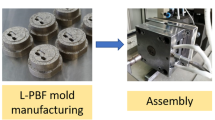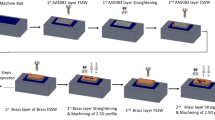Abstract
As a suitable mass and cost efficiency fabrication method, micro injection molding is doing a very good performance in micro plastic parts production. The mold design is an important part affecting micro parts properties. In this study, a micro injection mold with multi cavities of micro tensile bar is used. These micro cavities are fabricated by a micro milling process in different cross section shapes (semicircle R = 0.5 mm, equilateral triangle D = 0.3 mm, and trapezoid D = 0.336 mm t = 0.2 mm bottom angle = 95°). With an Arburg® 320C injection molding machine, micro tensile test sample are prepared in different processing parameters so that a correlation between the cross section shapes with micro weld line strength in different conditions could be investigated by tensile test. Final results show that when the cross section shape is different, their corresponding weld line strength is also different. Equilateral triangle cross section is leading to strongest weld line, and then followed by trapezoid, semi-circle is the last. By analysis of these tensile test results, the quantitative factor a is defined as the ratio of perimeter to area of cross section shape, and higher a value is corresponding stronger weld line. After weld line strength comparison in different processing conditions, the results show that higher injection pressure induced to lower weld line strength whatever the cross section shape is. By higher mold and melt temperature, equilateral triangle cross section gives improved weld line strength. But mold and melt temperature affect weld line strength negative for other cross section shapes.











Similar content being viewed by others
References
Boyanova M, Baltá Calleja FJ, Fakirov S, Kuehnert I, Mennig G (2005) Influence of processing conditions on the weld line in doubly injection-molded glassy polycarbonate and polystyrene: micro indentation hardness study. Adv Polym Technol 24(1):14–20. doi:10.1002/adv.20028
Chang TC, Faison E (1999) Optimization of weld line quality in injection molding using an experimental design approach. J Inject Molding Technol 2:61–66
Cho K, Ahn S, Park J, Park C, An JH (1997) Evaluation of the weld-line strength of thermoplastics by compact tension test. Polym Eng Sci 37:1217–1225. doi:10.1002/pen.11766
Kim JK, Song JH, Chung ST, Kwon TH (1997) Morphology and mechanical properties of injection molded articles with weld lines. Polym Eng Sci 37:228–241. doi:10.1002/pen.11665
Klein H, Schulz J, Spennemann A, Ziegmann C (2000) Machine and process development for micro engineering. IKV-Kolloquium Block 1:20
Koster RP (1999) Importance of injection molding parameters for mechanical performance of cold flow weld lines. J Inject Molding Technol 3:154–158
Michaeli W, Spennemann A (2001) A new injection moulding technology for micro parts. J Polym Eng 21:87
Michaeli W, Rogalla A, Ziegmann C (2000) Processing technologies for the injection moulding of hybrid micro structures. Macromol Mater Eng 279:42–45. doi:10.1002/1439-2054(20000601)279:1<42::AID-MAME42>3.0.CO;2-P
Moon SJ, Lee SS, Lee HS, Kwon TH (2005) Fabrication of microneedle array using LIGA and hot embossing process. Microsyst Technol 11:311–318. doi:10.1007/s00542-004-0446-8
Spennemann A, Michaeli W (1999) Process analysis and machine technology for the injection molding of microstructures. Proc ANTEC Soc Polym Eng 405:768
Turng LS, Kharbas H (2003) Effect of process conditions on the weld-line strength and microstructure of microcellular injection molded parts. Polym Eng Sci 1:157. doi:10.1002/pen.10013
Wechsung R, Fatatry AE, Goetz F, Illing M, Lawes RA, Tachulena G, vande Weijer F, Wicht H, Zinner H (2002) Market analysis for Microsystems II 2002–2005, NEXUS Task Force Report
Wicht H, Bouchaud J (2005). Nexus Market Anal MEMS Microsystems III: 2004–2009. In: Proceedings of commercialization of micro and nano systems conference
Wintermantel E, Ammer D, Kosthorst T (2008) Mit echtzeitregelung zur mikropraezision. Kunststoffe 6:70–73
Wu CH, Liang WJ (2005) Effects of geometry and injection-molding parameters on weld line strength. Polym Eng Sci 45:1022–1030
Xie L, Ziegmann G (2008) Study on correlation between mechanical properties of weld line and processing parameters in micro injection molding process of PP (Polypropylene). In: 2008 Proceedings of the PPS international Pol. Pro. Soc. Salerno, Italy
Xie L, Ziegmann G (2008b) A visual mold with variotherm system for weld line study in micro injection molding. Microsyst Technol 14:809–814. doi:10.1007/s00542-008-0566-7
Acknowledgments
The author would like to thank Deutscherforschungsgemeinschaft (DFG) give financial support for this research project.
Author information
Authors and Affiliations
Corresponding author
Rights and permissions
About this article
Cite this article
Xie, L., Ziegmann, G., Hlavac, M. et al. Effect of micro tensile sample’s cross section shape on the strength of weld line in micro injection molding process. Microsyst Technol 15, 1031–1037 (2009). https://doi.org/10.1007/s00542-009-0877-3
Received:
Accepted:
Published:
Issue Date:
DOI: https://doi.org/10.1007/s00542-009-0877-3




